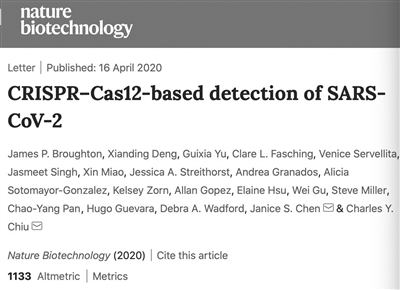Novel coronavirus rapid diagnosis technology based on CRISPR appears
Novel coronavirus rapid diagnosis technology based on CRISPR appears
Results were obtained in 45 minutes, and the accuracy was similar to that of traditional rt-pcr
Post date: 2020-04-20
A novel coronavirus can be detected by a crispr-based diagnostic tool, according to a biomedical study published in the journal nature biotechnology on June 16.
The diagnostic tool takes about 45 minutes to produce results, about the same accuracy as a traditional rt-pcr test.

Previous pandemics have taught that rapid and readily available tests are important for achieving an effective public health response.
However, current novel coronavirus tests often take hours or even days to produce results.
A novel coronavirus from a novel coronavirus pneumonia patient's respiratory swab was identified by a crispr-cas12 test, according to university of California researcher hua yan qiu and colleagues.
The test is called "novel coronavirus dna-targeted CRISPR trans-reporting system."
The test takes a sample of RNA, which is then reverse-transcribed into the DNA and amplified using a technique called isothermal amplification.
The novel coronavirus envelope and nucleocapsid sequences can then be detected by crispr-cas12, which cleaves the reporting molecule that confirms the virus's presence.
The team tested the system using clinical samples from 36 novel coronavirus pneumonia patients and 42 patients with other respiratory diseases.
Compared with the rt-pcr test used by the U.S. centers for disease control and prevention, the test had a 95% positive prediction coincidence rate and a 100% negative prediction coincidence rate.
Previous rt-pcr tests generally required a wait of several hours and the use of special equipment for cooling and heating cycles.
The latest crispr-based method, by contrast, has only two fixed operating temperatures and, after about 45 minutes, reads the results on a visual readout bar, like a home pregnancy test.
Source: science and technology daily
The copyright of this article belongs to the original, does not represent the position of this site.
We reprint this article for the purpose of disseminating more information.